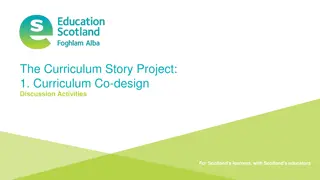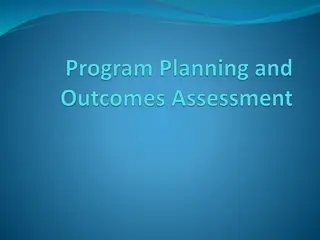Understanding Curriculum Design and Program Outcomes in Education
Exploring the critical terms COs and POs, this content delves into the short definitions of COs and POs, emphasizing the mapping of COs onto POs. It highlights how curriculum, assessment, and evaluation are integral in achieving program outcomes. The significance of SAR in evaluating curriculum development processes is discussed, along with the involvement of various stakeholders in curriculum review and design.
Download Presentation

Please find below an Image/Link to download the presentation.
The content on the website is provided AS IS for your information and personal use only. It may not be sold, licensed, or shared on other websites without obtaining consent from the author. Download presentation by click this link. If you encounter any issues during the download, it is possible that the publisher has removed the file from their server.
E N D
Presentation Transcript
Curriculum Design & Teaching-Learning August, 2019
Short Definitions of CO, PO Program Outcomes- POs These are knowledge and skill sets that the graduates have at the time of graduations Course Outcomes- COs Again, these are knowledge and skills that are attained by the graduates in a course {Could be a part of a PO} COs are mapped onto POs { CO-PO matrix}
Curriculum Curriculum, Assessment and Evaluation are the major tools by which Program Outcomes are attained. We should look at all of these together. These need to be designed well.
In Curriculum, SAR Seeks Answers to: Process for developing the curriculum exists and has been followed? The curriculum is well balanced? Level of syllabi is at the degree level? Does it allows the NBA Program Outcomes to be attained (critical)?
Two Themes: Process & Results
Qu. Will We be able to Attain POs Under the Curriculum?
Participants in Curriculum Review/ Design More True for Tier-1, But Faculty {Team} Industry Academics from Peer Institutions {Very Desirable} Students and Alumni Academic Bodies
The Curriculum Committee Needs to Keep in view also The PEOs & Resources
For Tier-1, the entire responsibility rests with the Institutions
Structure of Curriculum of a Typical Engineering Program
Broad Outline Mathematics, Physics, Basic Engineering Sciences, Humanities, Communication Core (Compulsory) Electrical Engineering Courses {Electives} Type 1 Type 2 Type 3 Type 4 Projects, Internships, Assignments, ..
1 Contents of Basic Science, Humanities, and Program Specific Courses Core, Elective 2 Content Delivery* 3 Laboratory Work 4 Project Work Questions in slide 5 need to be answered along with evidence: Processes of Development with documentation?
Content Delivery Class notes of students Course files* Text books used. Any Demos during the lectures? Attending lecture(s)- {Visit Schedule}
Course Files Much (though not all) of the Evidence for Direct Evaluations will come from the course files. Importance of Detailed and well maintained course files can not be overstated. It is the prime responsibility of the faculty. EE-201
Framework PEO Program Outcomes 3 Curriculum & Course Outcomes Teaching, Learning 2 1
For Evaluators Records? Curriculum Design Flow Define PEOs Place Starting Design alongside NBA s Program Outcomes. Can you cover All POs within the Credit Limit Requirements? If Yes, then Sequencing Requirements? Else, In a Few iterations a Solution should emerge {Hopefully}
Sample Syllabus Course: Electrical Circuits and Network Theory. Offered in either 2nd or 3rd semester to students of Electrical Sciences. Credits: (Typical) 3-1-0. Course is Compulsory. Course Objective: To prepare a student to take courses normally offered in subsequent semesters, like: Electronic Circuits, Signals and Systems, Advanced Electronics, etc. Syllabus: The circuit concept as an approximation to a physical system {modeling, Application of laws of physics (PO 1)}. Kirchoff s Laws, voltage and current sources, Network equations, use of source transformations, Loop and Nodal analysis, Matrix representation of circuit equations and their solutions {Apply knowledge of mathematics (PO1)} Continued
Transient response, solution of differential equations with constant coefficients, initial and final conditions, time constant, its physical significance, and use in solving engineering problems {PO 2 particularly, switching circuits}.Use of Laplace transform in circuit analysis {again PO 1} Two-port networks, two-port parameters {necessary for all the electronics systems that would follow}, sinusoidal steady state analysis and frequency response Use of computers for solving large problems {PO 5} Text books: 1.Van Valkenburg, Network Analysis, 3rd Edition, PHI. {For an 8 credit advanced course} 2. V Del Toro, Electrical Engineering Fundamentals, 2nd Edition {For a 6 credit standard course} Course Outcomes: PO 1, PO 2, PO 5 Reference: The Mathematics of Circuit Analysis, E.A. Guillemin, Oxford & IBH
Some Sample COs Course Digital Electronics Module Karnaugh Map of Course Outcome Students will be Able to simplify Boolean Expressions Logic Functions Interfacing different Logic Families Students acquire ability to design digital systems by selecting different families in view of speed and power requirements.
It is a Good Practice to embed Course Outcomes (CO) in the Syllabus
One More Example of COs Basic electrical circuits UC Davis, Relationship to Outcomes: Students who have successfully completed this course should have achieved: Professional Component - Engineering Foundation Course Outcomes ABET outcomes A A--An ability to apply knowledge of mathematics, science, and engineering
Electronic Circuits And Systems Students who have successfully completed this course should have achieved: Course Outcomes ABET outcomes An ability to apply knowledge of mathematics, science, and engineering A An ability to use the techniques, skills, and modern engineering tools necessary for engineering practice. K
One more Example Next Three Slides University of Florida Department of Electrical and Computer Engineering From the Course : Foundations of Digital Signal Processing Semester Fall 2018
Foundations of Digital Signal Processing, EEL 4750/5502 Course Description {Good Idea} This course covers topics related to the foundations of digital signal processing. After completing this course, students should understand the essential properties of discrete -time signals and systems; understand the sampling and reconstruction of signals; be able to perform transform analysis of digital signals and systems, and apply filter design techniques; as well as understand the fundamental principles
Course Objectives {Course Outcomes} At the conclusion of this course, you should be able to: Apply discrete-time systems to discrete-time signals Explain aliasing caused by under-sampling data Apply convolution and correlation to modify and locate signals Design a system with the Z-transform Create a Fast Fourier transform algorithm Analyze data with the short-time Fourier transform / spectrogram Design FIR & IIR filters for modifying time-domain signals Analyze data with a multi-channel filter bank Apply linear prediction for optimal filtering
Recommended Materials Digital Signal Processing, 4th edition o Authors: John G. Proakis and Dimitris K. Manolakis o Publisher: Prentice Hall, 2006 EEL 4750/EEL 5525 Course notes o Author: Joel B. Harley Recommended Software MATLAB (maybe Python)
Typical Documents Needed by Evaluators Curriculum Development Process Documents- {Committee constitution, Participants, Agendas and Minutes of meetings, etc}* Courses of Study Bulletin- {Syllabi, Text books, Reference material, Credit structure, etc.}
Have we answered all the questions that we had raised at the beginning?
In Curriculum, SAR Seeks Answers to: Process for developing the curriculum exists and has been followed? The curriculum is well balanced? Level of syllabi is at the degree level? It allows the NBA Program Outcomes to be attained (critical)
Q1. Process for developing the curriculum exists and has been followed? Yes / No?
Yes, Surely, But How did it come into being? Here, an Excellent curriculum! Evaluator Dean /HOD
Q.2 Curriculum Well Balanced? What does it mean?
Task Force on the Undergraduate Educational Commons Massachusetts Institute of Technology, October 2006 General Institute Requirements, the rigorous foundation in natural science, mathematics, technology, humanities, arts, and social sciences that forms the core curriculum of an MIT undergraduate education. The Task Force affirms the many ways in which this common curriculum has successfully prepared MIT s graduates for a lifetime of learning and leadership
ABETs Take on Balance The curriculum must support attainment of the student outcomes and must include: (a) one academic year of a combination of college-level mathematics and basic sciences (some with experimental experience). (b) one and one-half academic years of engineering topics, of engineering sciences and engineering and utilizing modern engineering tools.
(c) a broad education component that includes humanities and social sciences, complements the technical content of the curriculum, and is consistent with the PEOs. Students must be prepared to enter the professional practice of engineering through a curriculum culminating in a major design experience based on the knowledge and skills acquired in earlier course work
Qu.: Rank the curriculum content distributions of the four programs in the table below. Course Cont. Curriculum Content (%) of total number of credits (a) (b) 5 20 5 10 (c) 15 15 (d) 15 12 Basic Sciences Engineering Sciences H & Soc. Sc Program Core Program Electives Open Electives Projects Internships/seminar s 5 45 20 5 10 5 10 15 10 10 20 5 10 20 10 5 20 5 10 15 10 5 28 5
We have seen the broad structure of an Engineering Curriculum and examined it for balance. So, it could be: 1. Well Balanced 2. Fairly Balanced 3. Could have been better Balanced Review Committee
Q 3. Level of syllabi is at the degree level? This is a judgment call that Experts have to take
Q4. Does it ( the Curriculum)allow the NBA Program Outcomes to be attained (critical) How? Was Answered in Part- 1
If All the Four Questions can be Answered in the Affirmative The Job is Done!
Summary- as per SAR 2.1.1. State the process for designing the program curriculum (10)* 2.1.2. Structure of the Curriculum (5) 2.1.3. State the components of the curriculum (5) 2.1.4. State the process used to identify extent of compliance of the curriculum for attaining the Program Outcomes. (10)*
Curriculum Teaching/Learning/Assessment/Evaluations Course Outcomes Program Outcomes If True, Done
Typical Core Composition for EE Mathematics* 4/5 courses Physics 3/4 Courses Chemistry 1/2 Biology (?) 1 Humanities and Social Sciences
Maths: Calculus (1/2), Linear Algebra, Discrete Maths, Complex Variables Physics: General Physics, Electricity & Magnetism (Adv), Modern Physics,
Important Takeaways Even in Curriculum Design Evidence matters. Define, Follow and Record the entire Design Process. All the Questions raised are answered.
Curiosity & "curiosity killed the cat" "but satisfaction brought it back".
Tier - 2 Curriculum Affiliating University It may or may not allow all POs to be attained. If Not, then . .























